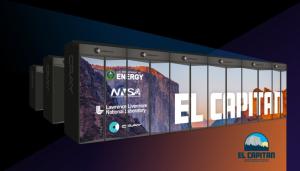LAB REPORT
Science and Technology Making Headlines
Aug. 29, 2019


Department of Energy (DOE) Secretary Rick Perry (center) emphasized the importance of advancing high performance computing and artificial intelligence to take on a number of transformative science opportunities during a special round-table discussion at LLNL. Also participating were Sandy Weill (left), whose Weill Family Foundation co-signed a memorandum of understanding with DOE Monday, and Dmitri Kusnezov, DOE deputy undersecretary, who moderated the discussion. Photo by Julie Russell/LLNL
A venture in artificial intelligence
Artificial intelligence, in the form of rapid collection and analysis of massive sets of biologic data, already has revolutionized medicine — by some estimates, the world’s fastest machines have processed more data in the past two years than in all of human history. But the technology needs to be much more powerful if it’s going to have real-world consequences for people with everything from traumatic brain injuries to cancer, kidney disease and Alzheimer’s.
That was the message Monday at a meeting of the country’s top scientists in brain and computational research at Lawrence Livermore National Laboratory, after which U.S. Energy Secretary Rick Perry signed an agreement with a major philanthropic foundation to promote formal partnerships between the Department of Energy and public and private institutions around the country.
Exactly what types of ventures the memorandum of understanding between the Energy Department and the Weill Family Foundation, based in New York, will support are not yet known. But the agreement could bolster a relatively new partnership between UCSF and scientists from the national labs in Livermore and Berkeley that is focused on processing enormous amounts of data from people with traumatic brain injuries, in hopes of developing better diagnostic equipment and even treatments.


LLNL physicist Arjun Gambhir helped develop an algorithm to solve equations on a quantum computer. Photo by Julie Russell/LLNL
The need for speed
An international team of researchers, including Lawrence Livermore National Laboratory (LLNL) physicist Arjun Gambhir, has developed a new algorithm for solving polynomial systems of equations using a type of quantum computer called a “quantum annealer.” The team systematically examined how this method scales when facing increasingly difficult mathematical equations, with promising results.
It has been theorized that quantum computers would enable researchers to solve problems much faster than they could with classical computing, or even tackle problems too complex for today’s supercomputers, but that “quantum speedup” has not yet been realized. This study provides evidence that quantum annealing could one day deliver these gains.
“We found that problems that are really hard to solve with classical computing scale differently with quantum annealing,” Gambhir said. “It was really interesting. When we made problems harder, the annealer didn’t have any more trouble, and in some cases the harder problems were actually easier to solve.”

The Department of Energy, National Nuclear Security Administration and Lawrence Livermore National Laboratory have signed contracts with Cray Inc. to build the NNSA’s first exascale supercomputer, “El Capitan.”
El Capitan to move mountains
Computer-maker Cray has been tapped to create a $600 million supercomputer to oversee the United States’ nuclear arsenal.
Nicknamed “El Capitan,” the exascale computer located at Lawrence Livermore will be capable of performing 1.5 quintillion (that’s a 1 followed by 18 zeros) calculations per second — which is believed to be the capacity of a human brain. It is predicted to be seven times faster than today’s fastest supercomputer — Cray’s Aurora.
Supercomputers are used to make sense of massive amounts of data on a scale far greater than commercially-available computers can perform. They’re used to study quantum physics, forecast global climate change and design aircraft. El Capitan will be tasked with helping to assess and maintain the U.S. nuclear stockpile for the Department of Energy and the National Nuclear Security Administration. It is scheduled to begin operating in 2023.


New research by LLNL shows that Jupiter’s stripes, caused by the planet’s zonal winds, only descend to 3,000 kilometers in the atmosphere. Image courtesy of NASA
Jupiter’s stripes are only skin deep
It turns out that Jupiter’s zonal winds — the alternating east-west jet streams seen in photographs as colorful stripes — only descend to 3,000 kilometers in the atmosphere, meaning that Jupiter’s stripes don’t go all the way down to the surface of the planet.
Magnetic fields can make fluids that conduct electricity (like Jupiter’s atmosphere) behave more like honey than water. Deeper into the planet, where the pressure is higher, the atmosphere becomes more conducting and is more strongly influenced by the planetary magnetic field. It’s also the same place where the stripes stop.
“The magnetically-enhanced viscosity could be strong enough to be the culprit that terminates the winds at depths below 3,000 km,” said Jeff Parker, Lawrence Livermore National Laboratory physicist.


LLNL scientists have created metal nanowire arrays that may improve solar cell efficiency.
Here comes the sun
Small wire meshes could let light in while conducting electricity out of solar arrays.
Transparent electrodes are critical in solar cells and electronic displays. In solar cells, the electrodes let sunlight pass through them and be converted into electricity, thereby improving the solar cell’s efficiency. In displays, they let light out and become part of a seamless display. For these types of tasks, engineers are looking for a transparent metal with high conductivity. The closest we come to that are metal oxides that collect electricity in a solar cell or send electricity through for a display. In those cases, you need a conductive contact (like a metal), but you also need to be able to let light in (for solar cells) or out (for displays).
Metal is opaque, so the current techniques use metal oxides, most often indium tin oxide. It is conductive and — if thin enough — transparent to visible light, but it reflects infrared. It is also a hard to find rare-earth metal. Because supplies of it are limited and expensive, researchers at Lawrence Livermore National Laboratory decided to use metal nanowire meshes that provide high transmissivity (due to the small diameters of the nanowires) and high electrical connectivity (due to the many contact points in the mesh) and used more common elements.





